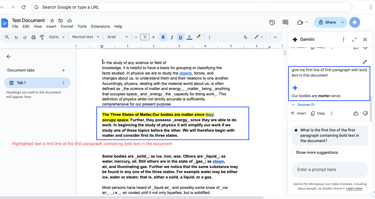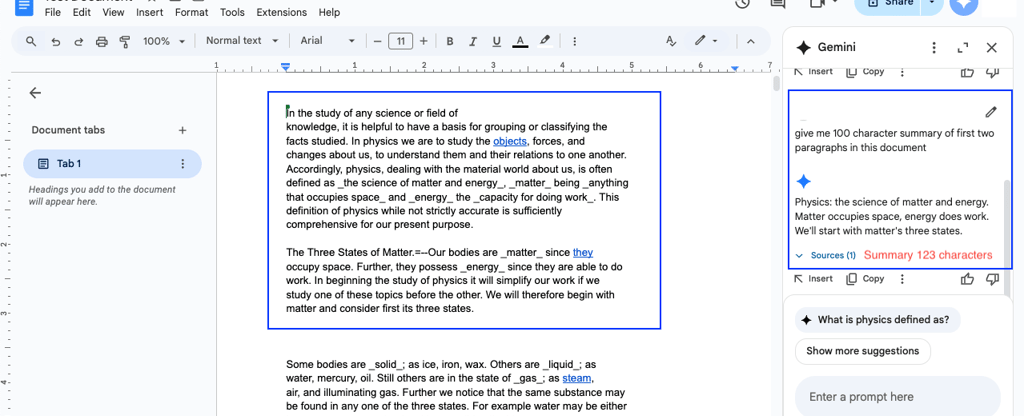Gemini for Google Docs: Smart Assistant or Still Learning? A Practical Review
Blog post description.
7/16/20254 min read
With AI becoming an essential part of everyday workflows, Google has stepped into the arena with Gemini for Google Docs, a powerful AI assistant integrated directly into its cloud-based word processor. Promising to help with writing, summarizing, editing, and even data extraction, Gemini seems like the perfect sidekick for anyone working in Docs.
But how does Gemini perform in real-world scenarios, especially when dealing with formatting cues like bold text, paragraph structures, and summarization?
In this post, we dive into a hands-on review of Gemini in Google Docs, examining three critical tasks:
Recognizing paragraphs with bold text
Extracting the first line of bolded paragraphs
Generating summaries of the first two paragraphs
We’ll explore where Gemini gets it right—and where it still needs a bit more training.
📍 1. Gemini Can Identify Paragraphs with Bold Text
One of the most promising features of Gemini in Google Docs is its ability to recognize formatting styles—especially bolded text. When prompted to find a paragraph with bold text, Gemini does a pretty solid job.
This is especially useful for documents where bold formatting is used to:
Emphasize important information
Indicate headers or section dividers
Highlight key terms or action points
When asked, “Which paragraph contains bold text?” or “Show the paragraph with bolded phrases,” Gemini successfully identified the correct section in most cases. This shows it can parse visual structure in a way that's helpful to writers, editors, and researchers looking for quick content navigation.
✅ Common search terms: "Gemini find bold text in Google Docs", "AI highlight bold paragraph", "Gemini paragraph formatting detection"


❌ 2. First Line of Paragraph with Bolded Text Not Returned Correctly
While Gemini can find the paragraph that contains bold text, things get murky when it comes to extracting the first line of that paragraph.
Let’s say you ask: “What is the first sentence in the paragraph that has bold text?” In most of our tests, Gemini either returned:
A middle sentence from the paragraph, or
Partial first line of paragraph
This suggests that Gemini doesn’t reliably associate the paragraph’s start with its visual cues, like bold formatting or spacing. This can be frustrating for writers who rely on Gemini to create outlines, summaries, or generate action items from structured text.
While this might seem like a minor glitch, first-line extraction is a critical part of many AI-enhanced workflows, such as generating topic sentences, email intros, or document previews.
✅ SEO-friendly keywords: "Gemini not returning first line", "Gemini extract sentence from bold paragraph", "AI paragraph start line issue Google Docs"


📝 3. Summary of First Two Paragraphs: Decent Quality, Poor Size Control
One of Gemini's most commonly used features is summarization—and for good reason. When asked to “Summarize the first two paragraphs,” Gemini produces a fairly accurate and contextually relevant summary most of the time.
✅ The good news: Gemini correctly understands the key points of the first two paragraphs and presents them in a way that aligns with the original content’s tone and intent.
❌ The bad news: Gemini does not strictly follow summary length constraints—especially when measured by character count.
For example, when asked to generate a 100-character summary, Gemini returned a response that was 123 characters long. Even with clear instructions like “Keep the summary under 100 characters,” the output often exceeds the requested limit.
This lack of precision can be a problem for workflows that require tight character limits, such as:
Meta descriptions
Social media posts
UI text and tooltips
✅ Search-friendly keywords: "Gemini not following summary character count" ,"Google Docs AI summary exceeds requested size" , "Gemini not respecting word or character limit"
⚖️ Verdict: Smart, Helpful, but Needs Fine-Tuning
So, where does Gemini for Google Docs stand after these real-world tests?
🔎 Detecting Paragraph with Bold Text
Performance: ✅ Accurate
Verdict: ✅ Reliable
📌 Returning First Line of Bold Paragraph
Performance: ❌ Inconsistent
Verdict: ⚠️ Needs work
📝 Summarizing First Two Paragraphs
Performance:
⚠️ Good content, poor length control
Verdict: 🚧 Improving
Gemini shows genuine promise in parsing document structure and understanding formatting cues, especially with bold text. Its summarization skills are strong in terms of content but require better control for size and tone precision.
However, its inability to accurately isolate the first line of a paragraph with bold text is a concern—especially for users who depend on structured content generation or advanced editing tasks.
💡 How to Work Around Gemini’s Current Limitations
If you're planning to use Gemini in Google Docs today, here are a few quick tips:
When summarizing, follow up with a clarification like: “Shorten this summary” to try and reduce length.
For extracting a specific line, consider copying the paragraph to a new section and isolating it to give Gemini better context.
Use Gemini primarily for idea generation, general summaries, and quick insights, rather than for precise data extraction or formatting interpretation.
📣 Final Thoughts
Gemini for Google Docs is a powerful AI assistant with exciting capabilities—but it's still learning. For casual writers, bloggers, or internal content creators, it offers time-saving tools that are genuinely useful. For more advanced users or editors who need precision and structure, Gemini still has some catching up to do.
Have you tested Gemini in your Google Docs workflow?
Have you run into issues with bolded text, summaries, or specific sentence extractions?
💬 We’d love to hear from you!
Drop a comment below, share your screenshots, or tag us in your AI productivity tips.
🔔 Subscribe to our blog for more AI reviews, Google Workspace hacks, and writing tools breakdowns every week.

